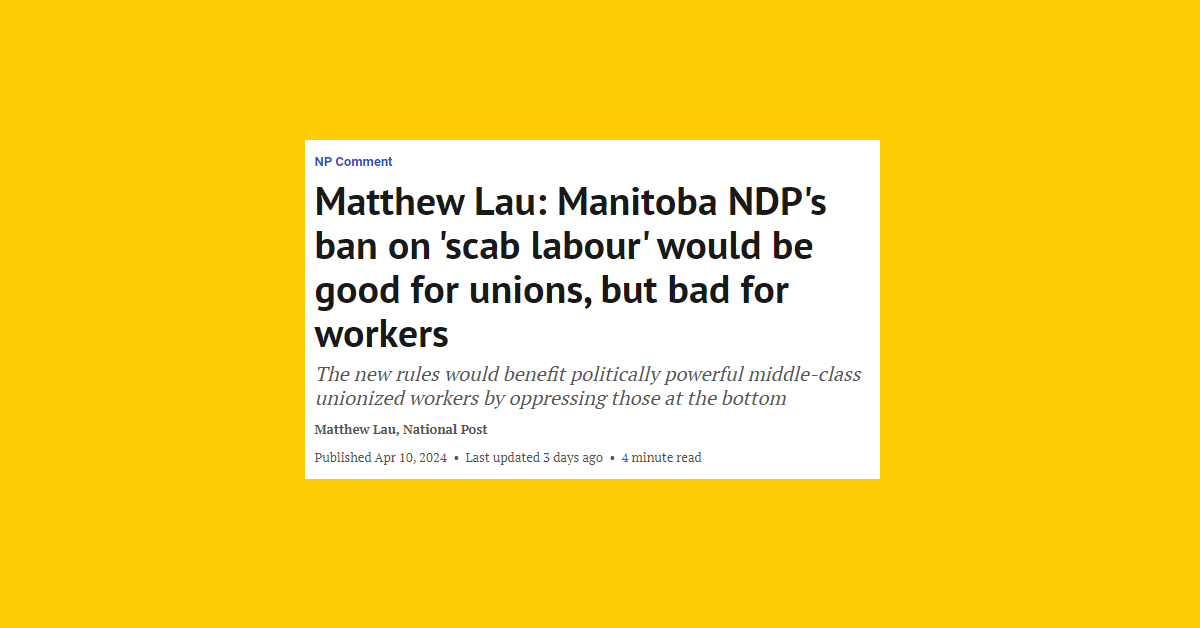
In late April, Statistics Canada released its annual Canadian Income Survey (CIS), reporting data from 2022. The CIS gives us a portrait of individual and household income in Canada. In the reporting year, average income fell as inflation spiked and governments terminated income benefits. In other words, the story told by this latest edition of the CIS is one of declining fortunes. For workers and their families, 2022 continued the downward income trend of the past two years.
In 2022, median after-tax income fell by 3.4 per cent from the year prior. According to StatCan, the average annual income for Canadian families and unattached individuals stood at $70,500, down from $73,000 in 2021.
This fall in median after-tax income was driven in large part by the federal government’s further withdrawal of pandemic-related income benefits. By the end of the CIS reporting year, all pandemic benefits had been discontinued and COVID-related modifications or enhancements to other programs had also been ended.
“Market income” remained largely steady between 2021 and 2022, when adjusted for inflation. In other words, pay from work remained basically stagnant, on average. This would be troubling enough on its own. At the same time, however, remaining pandemic benefits were either discontinued or unwound, leaving many working families worse off than they were in the previous year.
For example, relaxed eligibility criteria that made it easier for unemployed workers to receive Employment Insurance (EI) benefits were done away with in 2022. The program then reverted back to its pre-pandemic rules, despite the federal government recognizing that eligibility for EI is overly rigid and exclusionary, holding a series of consultations, and promising to reform the program. Workers now need to have worked the same number of insurable hours to access benefits as they did before COVID-19 upended the economy and exposed the gaping holes in our social safety net.
Consequently, the number of EI recipients fell from roughly four million in 2021 to 2.9 million in 2022. Not only did the total number of beneficiaries decline but so too did the average amount of benefit income collected. The median benefit income collected by EI recipients fell by a little more than 40 per cent, going from $10,100 in 2021 down to $5,900 in 2022.
This fall in collected EI benefits contributed to an overall decline in the average size of government benefits per household. Median government transfers fell by 28.9 per cent, or $4,100, going from $14,200 in 2021 to $10,100 in 2022. Although total benefits remained slightly above their pre-pandemic level, this is the second year in a row that average government transfer payments have fallen, as COVID-19 programs were slowly eliminated and no additional or permanent income supports replaced them.
The share of government transfers in total income therefore fell back to its pre-pandemic level of 13 per cent in 2022. Although pandemic programs pushed the share of government transfers higher than normal, these income benefits also proved decidedly impactful in reducing poverty and improving living standards. Instead of heeding the lessons of this enhanced social welfare, governments have chosen instead to reimpose the status quo and consign greater numbers of working families to poverty.
Indeed, according to the CIS, poverty increased noticeably in 2022. Given the withdrawal of vital benefits and the consequent fall in media income, this is hardly surprising. StatCan reports that the official poverty rate for 2022 was 9.9 per cent, an increase of 2.5 percentage points from 2021. In other words, nearly one in 10 Canadian households were living in poverty in 2022. This amounts to 3.8 million Canadians living below the poverty line — a disgraceful figure in a country this wealthy. When it comes to the share of ‘officially poor’ Canadians, we are nearly back to where we were prior to the pandemic: In 2019, the poverty rate stood at 10.3 per cent.
Worse still, the rate of child poverty increased by a greater amount than poverty overall. In 2022, the share of children under 18 years old living below the poverty line rose by 3.5 percentage points, to 9.9 per cent. Child poverty is now slightly higher than it was before COVID-19, with one in 10 children living in poverty.
Among seniors as well, benefit retrenchment has driven up poverty marginally. Among those 65 years and older, the poverty rate in 2022 stood at 6 per cent, up from 5.6 per cent the year prior and 5.7 per cent before the pandemic in 2019.
Despite Canada having relatively strong income support programs directed at children and the elderly, 2022 nevertheless saw poverty rise among both groups. This is a troubling yet entirely predictable development. When adequate protection is not forthcoming, vulnerable Canadians bear the brunt.
Other vulnerable groups including unattached individuals, lone-parent households, racialized Canadians, people with disabilities and recent immigrants similarly saw reductions in income and experienced greater poverty.
Unattached individuals and lone-parent households remain especially vulnerable to poverty and economic stress. In 2022, more than one-quarter (26 per cent) of the former group were living below the poverty line, up 4.1 percentage points from 2021. Unattached individuals registered a poverty rate nearly four times higher than families. Lone-parent households as well saw a significant rise in poverty, going from a low of 13.5 per cent in 2020 to 22.6 per cent in 2022. In particular, female-headed lone-parent households were nearly four times more likely to be living in poverty than people in couples with children. This is a failure of policy, plain and simple.
Racialized Canadians saw their poverty rate jump 3.5 percentage points in 2022, up to 13 per cent. Among Indigenous peoples, poverty stood at 17.5 per cent in 2022, nearly double that of non-Indigenous people as a whole. Furthermore, as the CIS reports, the income gap between Indigenous and non-Indigenous people widened between 2020 and 2022.
People living with disabilities experienced a smaller increase in poverty in 2022, up 1.7 percentage points to 12.3 per cent in 2022. Although the poverty rate among persons with disabilities remains below its pre-pandemic level, this is hardly worth celebrating. Canada does comparatively poorly when it comes to spending on supports for people living with disabilities. Hope that a new federal disability benefit would improve this situation now seems dashed by the plan’s meagre proposed amount.
Last, poverty also grew among recent immigrants, rising from 8.1 per cent in 2021 to 10.7 per cent in 2022. Moreover, as the CIS reports, “The more recent an immigrant’s arrival, the more likely they are to be below the poverty line.” Among those with five years or less in Canada, poverty stood at 16.4 per cent.
The latest Canadian Income Survey paints a stark picture of the fortunes of Canadian households post-pandemic. In 2022, workers and their families were squeezed by fiscal retrenchment on one side and inflation on the other. As the government wound down income supports that provided a lifeline to Canadian working families, inflation surged, averaging 6.8 per cent over the course of 2022. Rising food, fuel and housing costs, in particular, placed additional pressure on workers’ pay and living standards. As StatCan reports, roughly 8.7 million people — 22.9 per cent of the population — lived in households that reported food insecurity at the beginning of last year.
Coming out of the pandemic, we saw a glimpse of what a more just economy might look like. A tighter labour market with rising wages and enhanced social spending to establish a strong floor of protections for all held out the promise of structural reform. These prospects seem to be slowly slipping away, a direct result of policy choices made to restore the power and privilege of the wealthy.
While unions have been fighting on the wage front, we haven’t seen a concerted effort to protect and extend the social welfare state. That desperately needs to change.
Recent Class Struggle Issues
- April 28 | Today Is The National Day Of Mourning For Lost Workers
- April 22 | Reviewing The State Of The Labour Market – March 2024
- April 17 | Debunking The Latest Pro-Scab National Post Article
- April 8 | Pay Transparency Is A Collective Win For Workers








Member discussion